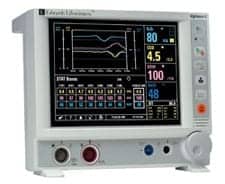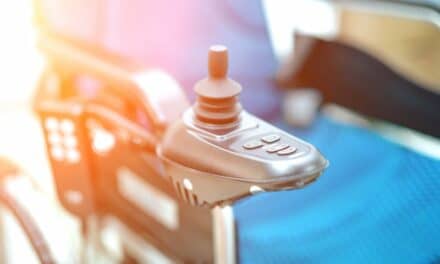There is a variety of pumps and monitors used in the health care industry; we will discuss three types of pumps that are used for applications ranging from the administration of IV solutions and anesthetic drugs to feeding solutions. They are generally tested for proper operation and accuracy by verifying their volume accuracy, their occlusion pressure accuracy, and, if so equipped, their various other sensors. We will also look at several types of monitors, whose applications range from monitoring fetal heart rate to monitoring cardiac rhythm disturbances.
Pump preventive maintenance month is dreaded by many BMETs, both because of their large quantity in most facilities and because of the extensive testing required. Regular replacement of backup batteries is always a good idea so that pump settings are retained during patient transportation and power outages.
IV Pumps
IV pumps use processes such as linear peristaltic action to pass fluids through an administration set that can carry a variety of solutions. A BMET should be prepared for just about any type of failure, partially due to the pumps’ frequent use and because of the abuse that they receive as they are transported to and from patient rooms, down corridors, to elevators, and to other areas that the patient might be required to go. On older units, volume accuracy can become a concern because of the aging of the pump’s mechanical components. In my experience, the occlusion sensor and its associated circuitry tend to have a significant number of out-of-tolerance failures. Unfortunately, these failures often go unnoticed.
Although not as widely used, there are infusion IV pumps that use drop sensors that also need to be tested.
Syringe Pumps
Syringe pumps usually incorporate some type of worm gear to push a syringe’s plunger in order to administer medications. Syringe pumps are sometimes equipped with a patient cable and are referred to as PCA (patient controlled analgesia) pumps. Syringe-pump volume accuracy tends to be very high with most manufacturers and models of pumps, although I have encountered syringe pumps that have had occlusion-sensor circuitry failures.
Enteral Feeding Pumps
Enteral feeding pumps use processes such as rotary peristaltic action to pass solutions through an administration set to dispense feeding solutions to patients. These devices tend to be less complex and their occlusion-detection circuitry tends to be more reliable than other types of pumps. The majority of the problems a BMET can expect to encounter are motor drive mechanism failures and battery failures.
Monitors
Monitors range from NIBP (noninvasive blood pressure) types with no CRT to full central-station monitors with 19-inch flat-screen displays. These devices tend to have few or no moving parts. Their failures usually involve cable accessories, buttons, and electrical or electronic components. Timely replacement of backup batteries is always a good idea so as to retain information during patient transportation and in the event of power outages. Over the years, analog CRT monitors have begun to be replaced with digital CRT monitors, electroluminescence displays, and color LCD displays. There are many different types of monitors, such as apnea, CO2, ECG, SaO2, fetal, oxygen, and NIBP. Each monitors a different bodily function, and there are devices on the market that can simulate each of those functions.
ECG/Respiration Monitors
Cardiac monitors are used to detect the frequency and duration of cardiac rhythm disturbances by means of a pair of electrodes, usually placed on the anterior part of the chest, that pick up the ECG and are connected by lead wires to the input circuit of the monitor. These monitors have been around for years and have evolved into very reliable devices. Points of possible failure on ECG monitors are the patient cables or leads. They can deteriorate, causing either erratic unstable signals or no signals at all—although these phenomena can also be caused by other factors.
One method of monitoring respiration rate is through impedance plethysmography, which employs low amplitude, high frequency (50 kHz to 500 kHz) alternating current between two surface electrodes to record thoracic movements or volume changes at the rib cage during a respiratory cycle. The voltage drop across the electrodes is computed as impedance, which increases during inspiration and decreases during expiration. Failure of monitor cables is common and the symptoms of failure are similar to those of an ECG cable failure (ie, the respiration signal can be distorted or not present at all).
Fetal Monitors
Fetal monitors measure a fetus’ heart rate by means of an ultrasound microphone or receptor, which can display the findings both auditorily and numerically. A uterine activity (UA) probe, which is able to measure abdominal movement on a woman in labor, is also used on these monitors. Some fetal monitors also incorporate a FECG (fetal electrocardiogram) for measuring the fetus’ heart rate. Ultrasound cable failures can be noticed when a static sound is heard coming from the monitor with little or no movement to the cable or no sound coming from the transducer during a test procedure. This usually indicates deterioration of the cable’s shielding. Uterine activity cable failure can be noticed when the monitor gives excessively high or low or no readings when no patient is connected to the transducer.
NIBP Monitors
Noninvasive blood pressure monitors measure a person’s blood pressure, usually by either oscillometric or auscultatory techniques. Normal blood pressure in an artery located in an extremity, such as the arm, is approximately 120/80. The top number is the systolic value and the bottom number is the diastolic value. Blood pressure can be taken from either the arms or legs. These devices have been known to function for years with little or no electronic problems. Buttons and leaks in tubing or the air compressor tend to be the cause of major problems encountered with these devices.
SpO2 Monitors
SpO2 monitors are designed to measure oxygen saturation in a person’s blood stream. These monitors generally use a probe placed on a finger, although there are types that can be placed on the ear.
SpO2 monitors have evolved over the past 60 years; today complete oximeters are available in a device just slightly larger than a matchbox that contains the monitor and the probe. These monitors will generally fail due to deteriorating sensors (eg, moisture entering the sensors), deteriorating wires located within the sensor cables, and random component failure.
As we have seen, BMETs in today’s health care facilities can expect to encounter not only a wide range of pumps and monitors, but they can also expect to encounter a wide range of failures with these devices. Fortunately, engineers and technicians are continually researching and developing new ways to lessen these failures. Through progressive research and development and with the help of engineers and technicians, health care facilities will achieve more reliable medical devices that will result in increased patient throughput and, in the process, create less work for today’s BMET.
Tim Hooks, CRES, CBET, is East Coast field engineer for Medstone International Inc, a Prime Medical company, in Aliso Viejo, Calif.




